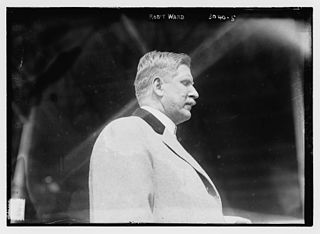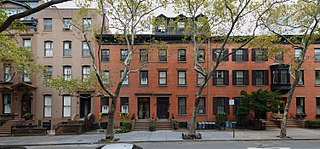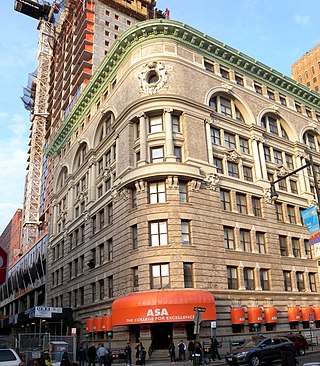
Lucy the Elephant is a six-story elephant-shaped example of novelty architecture, constructed of wood and clad in tin in 1882 by James V. Lafferty in Margate City, New Jersey, approximately five miles (8 km) south of Atlantic City. Originally named Elephant Bazaar, Lucy was built to promote real estate sales and attract tourists. Today, Lucy is the oldest surviving roadside tourist attraction in America.

A bagel is a bread roll originating in the Jewish communities of Poland. Bagels are traditionally made from yeasted wheat dough that is shaped by hand into a torus or ring, briefly boiled in water, and then baked. The result is a dense, chewy, doughy interior with a browned and sometimes crisp exterior.

A bakery is an establishment that produces and sells flour-based baked goods made in an oven such as bread, cookies, cakes, doughnuts, bagels, pastries, and pies. Some retail bakeries are also categorized as cafés, serving coffee and tea to customers who wish to consume the baked goods on the premises. In some countries, a distinction is made between bakeries, which primarily sell breads, and pâtisseries, which primarily sell sweet baked goods.

Prospect Heights is a neighborhood in the northwest of the New York City borough of Brooklyn. The traditional boundaries are Flatbush Avenue to the west, Atlantic Avenue to the north, Eastern Parkway – beginning at Grand Army Plaza – to the south, and Washington Avenue to the east. In the northern section of Prospect Heights are the Vanderbilt Rail Yards, built over as part of the Pacific Park project. The Barclays Center, home to the NBA's Brooklyn Nets basketball team, is located in the northwestern corner of the neighborhood in Pacific Park at Flatbush and Atlantic Avenues.

Bialy, originally from the city of Białystok in Poland, is a traditional bread roll in Polish Ashkenazi Jewish cuisine.

Barclays Center is a multi-purpose indoor arena in the New York City borough of Brooklyn. The arena is home to the Brooklyn Nets of the National Basketball Association and the New York Liberty of the Women's National Basketball Association. The arena also hosts concerts, conventions and other sporting and entertainment events.

Pacific Park is a mixed-use commercial and residential development project by Forest City Ratner that will consist of 17 high-rise buildings, under construction in Prospect Heights, adjacent to Downtown Brooklyn, Park Slope, and Fort Greene in Brooklyn, New York City. The project overlaps part of the Atlantic Terminal Urban Renewal Area, but also extends toward the adjacent brownstone neighborhood. Of the 22-acre (8.9 ha) project, 8.4 acres (3.4 ha) is located over a Long Island Rail Road train yard. A major component of the project is the Barclays Center sports arena, which opened on September 21, 2012. Formerly named Atlantic Yards, the project was renamed by the developer in August 2014 as part of a rebranding.
Thomas' is a brand of English muffins and bagels in North America, established in 1880. It is owned by Bimbo Bakeries USA, one of the largest baking companies in the United States, which also owns Entenmann's, Sara Lee, Stroehmann, and Arnold bread companies. Advertisements for the muffins place emphasis on their "nooks and crannies". The company also produces toasting or swirl breads, pitas, wraps, and bagels.

The Brooklyn Tip-Tops were a team in the short-lived Federal League of professional baseball from 1914 to 1915. The team's name came from Tip Top Bread, a product of Ward Baking Company, which was also owned by team owner Robert Ward. They were sometimes informally called the Brooklyn Feds or BrookFeds due to being the Brooklyn team of the Federal League. They played in Washington Park, which the Brooklyn Dodgers had abandoned after the 1912 season to move to Ebbets Field.

The Montague–Court Building is a 35-story, 462 ft (141 m) tall commercial office tower at 16 Court Street in Downtown Brooklyn, New York City. It was designed by architect H. Craig Severance and built in 1927. It is the tallest office building and the twelfth tallest building overall in Brooklyn at 462 feet. The building is 35 stories tall and has a floor area of 317,625 sq ft (29,508.3 m2). The Montague–Court Building has been owned and managed by the CIM Group since 2017, when CIM purchased the structure from SL Green Realty for $171 million. In February 2012, the New York City Landmarks Preservation Commission designated the building as part of the Borough Hall Skyscraper Historic District.

The Brooklyn Heights Historic District is a historic district that comprises much of the Brooklyn Heights neighborhood of Brooklyn, New York City, United States. It was named a National Historic Landmark in January, 1965, designated a New York City Landmark in November, 1965, and added to the National Register of Historic Places in October, 1966.

The Continental Baking Company was one of the first bakeries to introduce fortified bread. It was the maker of the Twinkie and Wonder Bread. Through a series of acquisitions and mergers it became part of the former Hostess Brands company.

Brooklyn Bowl is a music venue, bowling alley and restaurant in the Williamsburg neighborhood of Brooklyn, New York. Founded in 2009, it is located in the former Hecla Iron Works Building at 61 Wythe Avenue. It is known for its high-tech green construction and variety of musical acts. In 2013 Rolling Stone named Brooklyn Bowl the 20th best music club in the United States.

Montrose W. Morris was an American architect from Brooklyn best known for some of the first multi-unit apartment buildings in New York City. His most well-known buildings include the Alhambra Apartments, Imperial Apartments, and the Renaissance Apartments all in Brooklyn, New York. Most of Morris’ work still stands adding greatly to the borough's architectural heritage. Morris worked in the prevalent architectural styles of the period, including Queen Anne and Romanesque Revival.

American Jewish cuisine comprises the food, cooking, and dining customs associated with American Jews. It was heavily influenced by the cuisine of Jewish immigrants who came to the United States from Eastern Europe around the turn of the 20th century. It was further developed in unique ways by the immigrants and their descendants, especially in New York City and other large metropolitan areas of the northeastern U.S.
General Host Corp. was a New York-based food and food-related company. It was also the owner of Frank's Nursery & Crafts until the company's bankruptcy in 2004.

The Willink Entrance area, also known as Willink Plaza, is a major urban square of Brooklyn, New York City, formed by the intersection of Flatbush Avenue, Ocean Avenue and Empire Boulevard, at the eastern corner of Prospect Park and the southern corner of the Brooklyn Botanic Garden. It is serviced by the New York City Subway's Prospect Park station, and features several public spaces and historic buildings. This location is considered the northwestern point of the Prospect Lefferts Gardens neighborhood of Flatbush, and adjoins Crown Heights to its northeast.

Rudolphe Lawrence Daus (1854–1916) was an American architect based in Brooklyn, New York City. He designed the 13th Regiment Armory in Brooklyn, now the Pamoja House for homeless men, and the Lincoln Club. He also designed several libraries. He was a Fellow of the American Institute of Architects.
Elizabeth Amelia Gloucester was one of the wealthiest black women in America at the time of her death and was a supporter of the Underground Railroad and a business owner.


















